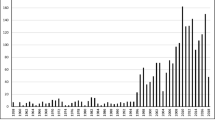Abstract
Participation in many cultural activity systems, such as art worlds or scientific communities, is highly skewed toward an elite creating a pattern of activity that emphasizes rationality and repeated events. At the same time, the introduction of new works and participants in these systems promotes the opposite, that is, innovation. Rationality and innovative interests are usually approached and analyzed separately, but this article examines a social context in which they are jointly produced—concert music programming. To analyze the dominance of repertory, this paper documents concert programming over a single season and describes a model to illustrate the observed distribution of events. The skewed distribution of programming is then explained through reference to the aesthetic interests of concert artists, that is, composers and performers, and the congruence of a rationalized aesthetic to the recruitment of audiences and administrative rationality.
Similar content being viewed by others
References
Aitchison, J. andJ. A. C Brown 1966 The Log Normal Distribution. Cambridge: Cambridge University Press.
Allison, Paul andJohn Stewart 1974 “Productivity differences among scientists.” American Sociological Review 39:596–606.
Arian, Edward 1971 Bach, Beethoven, and Bureaucracy. University: University of Alabama Press.
Broadcast Music, Inc. 1971 BMI Orchestral Program Survey. New York: BMT.
Burger, Peter 1984 The Theory of the Avant Garde. Minneapolis: University of Minnesota Press.
Bystryn, Marcia 1978 “Art galleries as gatekeepers.” Social Research 45:390–408.
Cole, Jonathan andStephen Cole 1973 Social Stratification in Science. Chicago: University of Chicago.
Coser, Lewis, Charles Kadushin, andWalter Powell 1982 Books. New York: Basic Books.
Crane, Diana 1987 The Transformation of the Avant Garde. Chicago: University of Chicago.
Daval, Jean-Iuc 1980 Avant-Garde Art. New York: Rizzolli.
DiMaggio, Paul 1977 “Market structure, the creative process, and popular culture.” Journal of Popular Culture 11:436–452.
DiMaggio, Paul andPaul Hirsch 1976 “Production Organizations in the Arts.” American Behavioral Scientist 19:735–752.
DiMaggio, Paul andKristen Stenberg 1985 “Conformity and diversity in American resident theaters.” In Judith Balfe and Margaret Jane Wyszomirski (eds.), Art, Ideology and Politics: 117–138. New York: Praeger.
Dubin, Steven 1987 Bureaucratizing the Muse. Chicago: University of Chicago.
Faulkner, Robert 1983 Music on Demand. New Brunswick, NJ: Transaction Books.
Ghiselin, Brewster 1952 The Creative Process. Berkeley: University of California.
Gibrat, R. 1931 Les Inegalites Economiques. Paris: Libraire du Recueil Sirey.
Gilmore, Samuel 1987 “Coordination and convention: The organization of the concert world.” Symbolic Interaction 10:209–228.
Hart, Philip 1973 Orpheus in the New World. New York: Norton.
Hess, Thomas andJohn Ashberry 1967 Avant-Garde Art. London: Collier-Macmillan.
Hirsch, Paul 1972 “Processing fads and fashions: An organization set analysis of cultural industry systems.” American Journal of Sociology 77:639–59.
Hirschman, Albert 1970 Exit, Voice, and Loyalty. Cambridge, MA: Harvard University Press.
Homans, George 1964 “Bringing men back in.” American Sociological Review 29:809–818.
Kerman, Joseph 1983 “A few canonic variations.” Critical Inquiry 10:107–125.
Kostelanetz, Richard 1982 The Avant-Garde Tradition in Literature. Buffalo, NY: Prometheus Books.
Martorella, Rosanne 1977 “The relationship between box office and repertoire: A case study of opera.” The Sociological Quarterly 18:354–366.
1963 Formal Theories of Mass Behavior. New York: Free Press.
1966 “When culture becomes a business.” In J. Berger, M. Zelditch, and B. Anderson (eds.), Sociological Theories in Progress. Boston: Houghton-Mifflin.
Merton, Robert 1968/1973 The Sociology of Science. Chicago: University of Chicago.
Meyer, Leonard 1967 Music, the Arts, and Ideas. Chicago: University of Chicago.
Mueller, John 1951 The American Symphony Orchestra. Bloomington: Indiana University Press.
Mueller, Kate 1973 Twenty Seven Major American Symphony Orchestras. Bloomington: Indiana University Press.
Nyman, Michael 1974 Experimental Music. New York: Schirmer Books.
Perrow, Charles 1967 “A framework for the comparative analysis of organization.” American Sociological Review 32:194–208.
Peterson, Richard 1986 “From impresario to arts administrator: Formal accountability in nonprofit cultural organizations.” In Paul DiMaggio (ed.), Nonprofit Profit Enterprise in the Arts: 161–183. New York: Oxford.
Peterson, Richard andDavid Berger 1975 “Cycles in symbol production.” American Sociological Review 40:158–73.
Phelps Brown, Henry 1977 The Inequality of Pay. Berkeley: University of California.
Poggioli, Renato 1968 The Theory of the Avant Garde. Cambridge: Belknap.
Raynor, Henry 1972 A Social History of Music. New York: Taplinger.
Rees, Albert 1973 The Economy of Work and Pay. New York: Harper & Row.
Rosenberg, B. andD. White 1957 Mass Culture. New York: Free Press.
Rosenberg, Deena andBernard Rosenberg 1979 The Music Makers. New York: Columbia University Press.
Schorske, Carl 1981 Fin-de-Siecle Vienna. New York: Vintage Books.
Shils, Edward 1981 Tradition. Chicago: University of Chicago.
1957a Models of Man. New York: John Wiley & Sons.
1957b Administrative Behavior. New York: MacMillan.
Stinchcombe, Arthur 1959 Bureaucratic and craft administration of production: A comparative study. Administrative Science Quarterly 4:168–87.
Thompson, James D. 1967 Organizations in Action. New York: McGraw-Hill.
Thompson, Virgil 1939/1983 The State of Music. New York: E. P. Dutton.
Weber, Max 1947 The Theory of Social and Economic Organizations. Glencoe, IL: Free Press.
1986 “The rise of the classical repertoire in nineteenth-century orchestral concerts.” In Joan Peyser (ed.), The Orchestra: 361–386. New York: Scribners.
1989 “The eighteenth-century origins of the musical canon.” Journal of the Royal Musical Association 118:6–17.
Yule, G. Udny 1944 The Statistical Study of Literary Vocabulary. Cambridge: Cambridge University Press.
Zipf, George 1949 Human Behavior and the Principle of Least Effort. Reading, MA: Addison-Wesley.
Zolberg, Vera 1980 “Displaced art and performed music: Selective innovation and the structure of artistic media.” Sociological Quarterly 21:219–231.
Author information
Authors and Affiliations
Rights and permissions
About this article
Cite this article
Gilmore, S. Tradition and novelty in concert programming: Bringing the artist back into cultural analysis. Sociol Forum 8, 221–242 (1993). https://doi.org/10.1007/BF01115491
Issue Date:
DOI: https://doi.org/10.1007/BF01115491



